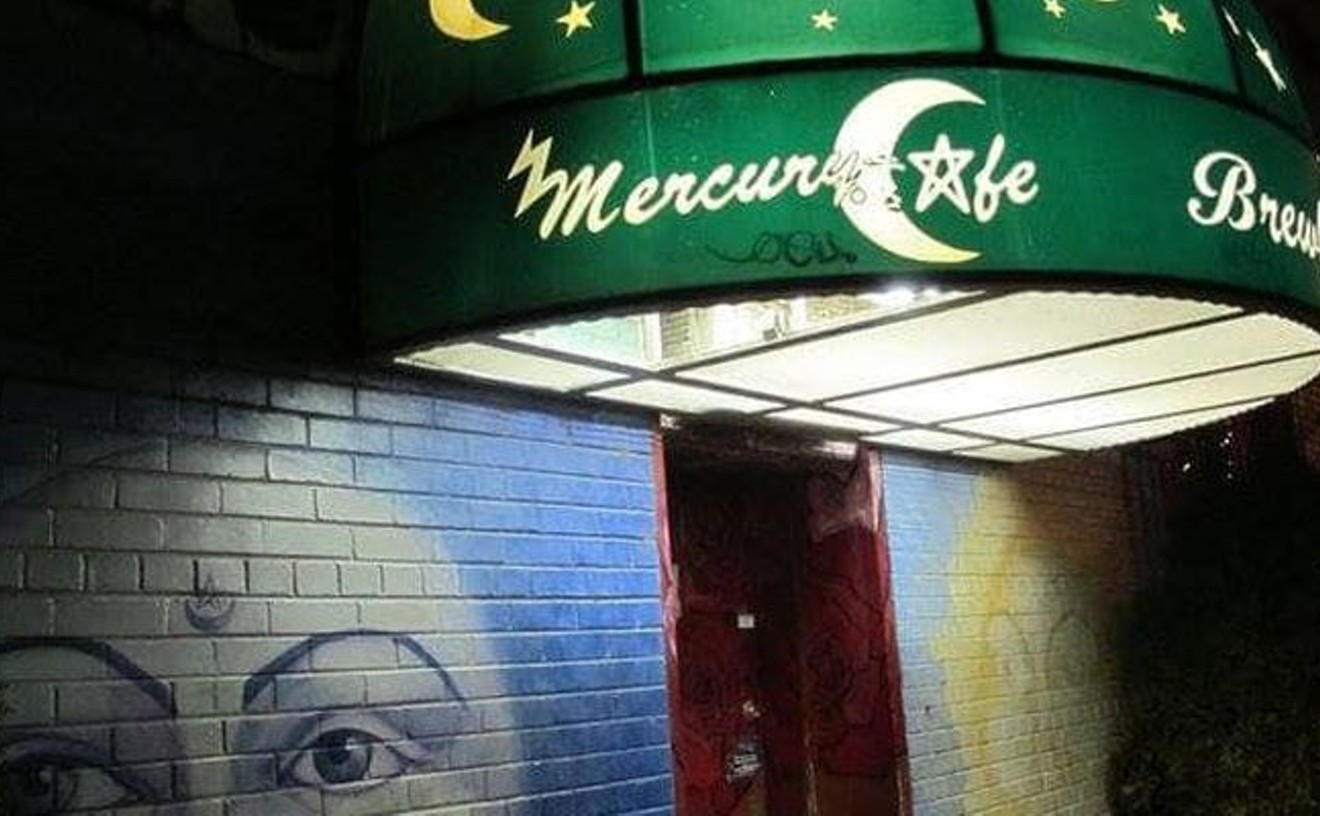There's Boardman Robinson, the social realist painter who worked in Colorado Springs in the '30s and '40s, and modernist master Herbert Bayer, who was painting, printing, sculpting and photographing up in Aspen from the '40s right through the '80s, as well as ceramicists Artus Van Briggle, Paul Soldner and Betty Woodman. And, of course, there's John DeAndrea, the hyper-realist sculptor whose work is seen in museums worldwide, including our own Denver Art Museum. "Linda," DeAndrea's acclaimed polyvinyl sculpture of a supine nude woman, demurely draped where necessary, is one of the DAM's best-known works of art, even if it's displayed only for short periods of time because of conservation concerns. "Linda" won't be back out at the DAM until December, but right now, Colorado's most accomplished contemporary sculptor is the subject of an incredible show at Ron Judish Fine Arts, titled simply yet sufficiently John DeAndrea.
DeAndrea was born in 1941 and raised in Denver's now-defunct Little Italy on the city's near-northwest side. "When I was a little kid, my dad commissioned Bill Joseph to create some wall sculptures for his Belmont Restaurant," recalls DeAndrea. "It was the first time I saw a grownup -- a grown man -- who was an artist."
Joseph, the dean of Denver's modern sculptors, created a trio of repoussé figures for DeAndrea's father, made of copper peened into a wooden form. "My dad had a lot of restaurants over the years, and he decorated every one, but he always brought those copper ladies with him from the Belmont," says DeAndrea. "I have them now, hanging at my house. I love those copper ladies."
DeAndrea, not surprisingly, became interested in art as a child and developed his enduring love of realism early on. "I was in the church the other day where I went when I was growing up, Our Lady of Mount Carmel," he says. "My family has gone there for generations and my mother still goes there all the time. Inside there are all these amazing realistic sculptures from Italy which are painted. They have more to do with what I eventually did as an artist than all the art education I was exposed to."
For DeAndrea, though, Mount Carmel was not the absolute source of his inspiration, but an intrinsic part of the cultural context that's central to his work. "It's about being Italian," he says. "The Italians have been great realists for thousands of years. When I first went to Italy, I suddenly knew why I did what I did, why I liked the foods that I like. I don't think it's genetics, but it goes deeper than what we're taught. Is it possible to expect that after a couple of generations you can reject what you've been for thousands of years?" he asks rhetorically.
DeAndrea received a BFA from the University of Colorado in Boulder in 1965 and then went on to the University of New Mexico in Albuquerque. In 1970 he got his big break, a solo show at the O.K. Harris Works of Art gallery in New York, that immediately brought him worldwide fame. His amazingly realistic figural sculptures, complete with meticulously painted skin, real hair and glass eyes, had appeared at just the right time. Their incredibly accurate detailing fit perfectly with the photo-realist movement of the '70s, itself an outgrowth of earlier pop art.
DeAndrea's figural sculptures are quite distinct from those of the late Duane Hanson, the only other sculptor to emerge from the photo-realist movement. "Hanson's sculptures have a social commentary element, while mine are classical figures," DeAndrea points out. Another, more obvious difference is that Hanson's figures are clothed, while DeAndrea's are shamelessly nude. (Although in recent years DeAndrea has also created dressed figures, he says he still prefers to do nudes.)
Despite his success in the contemporary art world, DeAndrea also sees himself at odds with it. "I'm at peace with my own work, but I battle contemporary art," he says. "I not only am not doing what I was taught to do, but I'm doing something that's against what I was taught to do."
DeAndrea's explanation for his super-realistic, fanatically detailed approach posits a fascinating challenge to modernism, and in this sense, his work may be seen as postmodern. "Abstraction is regarded as sophisticated but it's actually primitive, but the modern world privileges the primitive," muses DeAndrea. "Realism is seen to be unsophisticated, or less sophisticated than abstraction, but it's actually a part of an extremely sophisticated tradition based on a refinement of a refinement of a refinement -- from the Greeks to the Romans to the Renaissance Italians." He knows his views put him in a difficult spot, even a no-man's land, because most of the artists who agree with him theoretically aren't contemporary artists, but the sort of neo-traditionalists seen in the current Artists of America show. "But they're interested in artist-made details, and I want to record the God-made details," says DeAndrea, obliquely referring to his life-casting method, in which molds are made from real people.
All of DeAndrea's influences -- from the actual human body to historical art prototypes to Italian religious art stretching from the Vatican to Mt. Carmel -- are exhibited in his moving, solo show. Although Ron Judish Fine Arts is filled with disturbingly accurate depictions of mostly nude women, the atmosphere isn't sexually charged, but instead spiritual and dignified. The effect is absolutely stunning.
You can see a portion of the show before you walk in the door, through the gallery's large display windows along Wazee Street, and this glimpse alone will take your breath away. (The exterior view is especially nice at night, when the gallery is, unfortunately, closed.) Through the windows, the first thing you see is one of DeAndrea's signature 1997-2000 painted polyvinyl sculptures, "Christine," a semi-recumbent female nude perched on a low stand that's painted white. "A few years ago, you couldn't put a sculpture like this in a window in Denver," says DeAndrea.
Although Denver's mores may have changed, it's still a little shocking to spot what looks like a live, naked lady lounging in a lighted window. But you can hardly blame Judish for placing the sculpture there, because "Christine" has had an impressive, positive impact on the gallery's traffic. During the time I was visiting, a number of passersby did a double take when they first spotted "Christine," and then, like moths to the flame, made a dash for the gallery's front door.
As you pass through that door, "Christine" is to your right. Immediately in front, in the center of the space, is a brand-new painted bronze called "Amber." This beautiful sculpture of an adolescent girl, dressed as a dancer in leotards, is markedly different from "Christine" and the rest of DeAndrea's more-familiar painted polyvinyl. With "Amber," for example, the hair is part of the casting, and not applied strand by strand. And "Amber" has painted eyes, rather than the glass eyes DeAndrea uses in his polyvinyl sculptures.
Although bronze isn't a new material for DeAndrea -- he did a few bronzes in the early 1980s -- over the past few years he's become increasingly interested in the medium. "I like getting into metal," he says, "and I have a lot of ideas that will go good with metal, but I will still do the plastic." (DeAndrea uses Tim Joseph's Fort Collins foundry for the bronze casting; Joseph is the son of Bill Joseph, DeAndrea's early role model.)
The front space features three more bronzes, busts rather than full figures, and 1993's "Garnet," a nude woman seated on a ready-made chair. More bronze busts appear in the narrow middle room, lined up on tall sculpture stands along one wall. Unlike the patinated busts in the front room, these have been painted realistically and are reminiscent of the ceramics of Luca della Robbia, a fifteenth century Renaissance sculptor. Opposite the busts is a fully reclining nude, "Karen," a painted polyvinyl done in 1993. "Karen" is lying face down, draped over a low sculpture stand.
There's a processional character to this space that's appropriate, considering the somber mood conjured up in the large back gallery. Only two sculptures, each lit in an otherwise darkened space, have been installed here. Ahead and to the left is the disturbing "Expulsion II," a 1992 painted polyvinyl sculpture of a standing woman, her arms attempting to hide her body. Her posture is tortured, conveying shame and fear. According to DeAndrea, the piece is based on Eve from Mosaccio's "Expulsion from Paradise," a fifteenth century Florentine painting. The other sculpture in the back is "American Icon," a 1990 painted polyvinyl based on the Kent State tragedy of 1970, when Ohio National Guardsmen gunned downed four unarmed student protesters. "American Icon" is a three-dimensional version of the most famous photo of the event, John Paul Filo's picture of a female student lamenting over the body of a young man lying face down on the ground. DeAndrea has painted the two-part sculpture, which really functions as an installation, in shades of black and white in honor of the original black-and-white photo. The effect is hair-raising.
John DeAndrea has gotten the royal treatment at Ron Judish Fine Arts, and he deserves it. The show is fabulous.










